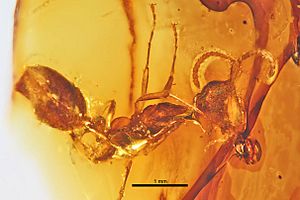Haidoterminus facts for kids
Quick facts for kids Haidoterminus |
|
|---|---|
 |
|
| Haidoterminus cippus holotype | |
| Scientific classification | |
| Genus: |
Haidoterminus
|
| Species: |
cippus
|
Haidoterminus was an extinct type of ant. It belonged to a special group of ants called Haidomyrmecinae. This group has only nine known types of ants. Haidoterminus itself has only one known species, called Haidoterminus cippus. Scientists found just one fossil of this ant in North America. This fossil is from the Late Cretaceous period, a very long time ago!
Discovering Haidoterminus
Scientists found only one adult fossil of Haidoterminus. This special fossil is called the holotype. It was given to scientists by Mark Elaschuk for study. The fossil was kept at the Strickland Entomology Museum at the University of Alberta.
The fossil is a mostly complete adult female ant. It was preserved inside a clear, yellow piece of Canadian amber. Amber is like fossilized tree sap. This amber was found in Canada, near Grassy Lake, Alberta.
Scientists believe the amber is about 79 to 78 million years old. This means the ant lived during the Campanian age of the Late Cretaceous period. The amber came from ancient cypress trees. It was likely formed in lagoons and salty marshes near a large ancient sea called the Western Interior Seaway.
Haidoterminus is one of five ant species found at the Grassy Lake site. The other ants found there include Sphecomyrma canadensis, Eotapinoma macalpini, Canapone dentata, and Cananeuretus occidentalis.
Paleoentomologists Ryan C. McKellar, Michael S. Engel, and James R.N. Glasier first studied this fossil. They published their findings in 2013 in the journal Canadian Entomology.
They named the genus Haidoterminus by combining Haidomyrmex (another ant group) with the Latin word terminus. Terminus means "end" or "boundary." This name was chosen because Haidoterminus was one of the last ants in its group to live. The species name cippus comes from the Latin word for "tombstone" or "pillar." This refers to the ant's unique face part, which looked like a pillar.
Haidoterminus is one of five genera (groups) in its family. The other four are Ceratomyrmex, Linguamyrmex, Haidomyrmex, and Haidomyrmodes.
What Haidoterminus Looked Like
The Haidoterminus worker ant fossil looks similar to ants in the Haidomyrmex group. It had very large and strong mandibles (jaws). These jaws looked like a scythe (a curved blade) when viewed from the side. They also had very narrow bases.
The whole ant fossil is about 3.2 millimeters (0.13 inches) long. It had small, oval-shaped compound eyes. These eyes were made of a few larger parts called ommatidia.
The ant's clypeus (a part of its face) was shaped like a bowl. It had several large bristles called setae, including two long "trigger" setae.
Its antennae were special because they had twelve segments. Other similar ants like Haidomyrmex and Haidomyrmodes only had eleven segments. The third segment of the antenna was long. The very last segment was shaped like a bulb. The antennae were covered in short, slanted bristles.

